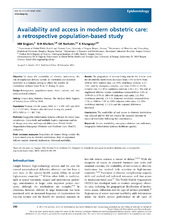Availability and access in modern obstetric care: a retrospective population-based study
Peer reviewed, Journal article
Published version
Permanent lenke
https://hdl.handle.net/1956/8866Utgivelsesdato
2014Metadata
Vis full innførselSamlinger
Originalversjon
https://doi.org/10.1111/1471-0528.12510Sammendrag
Objective: To assess the availability of obstetric institutions, the risk of unplanned delivery outside an institution and maternal morbidity in a national setting in which the number of institutions declined from 95 to 51 during 30 years. Design: Retrospective population-based, three cohorts and two cross-sectional analyses. Setting: Census data, Statistics Norway. The Medical Birth Registry of Norway from 1979 to 2009. Population: Women (15–49 years), 2000 (n=1 050 269) and 2010 (n=1 127 665). Women who delivered during the period 1979–2009 (n=1 807 714). Methods: Geographic Information Systems software for travel zone calculations. Cross-table and multiple logistic regression analysis of change over time and regional differences. World Health Organization Emergency Obstetric and Newborn Care (EmOC) indicators. Main outcome measures: Proportion of women living outside the 1-hour travel zone to obstetric institutions. Risk of unplanned delivery outside obstetric institutions. Maternal morbidity. Results: The proportion of women living outside the 1-hour zone for all obstetric institutions increased from 7.9% to 8.8% from 2000 to 2010 (relative risk, 1.1; 95% confidence interval, 1.11– 1.12), and for emergency obstetric care from 11.0% to 12.1% (relative risk, 1.1; 95% confidence interval, 1.09–1.11). The risk of unplanned delivery outside institutions increased from 0.4% in 1979–83 to 0.7% in 2004–09 (adjusted odds ratio, 2.0; 95% confidence interval, 1.9–2.2). Maternal morbidity increased from 1.7% in 2000 to 2.2% in 2009 (adjusted odds ratio, 1.4; 95% confidence interval, 1.2–1.5) and the regional differences increased. Conclusions: The availability of and access to obstetric institutions was reduced and we did not observe the expected decrease in maternal morbidity following the centralisation.

